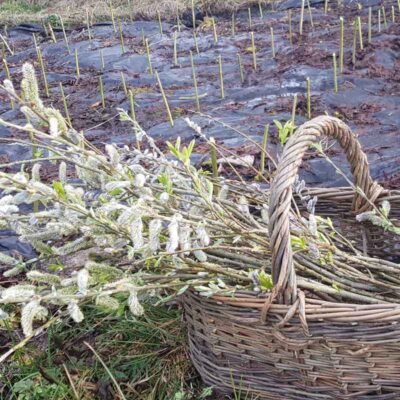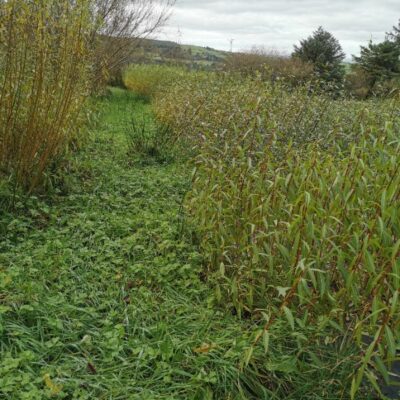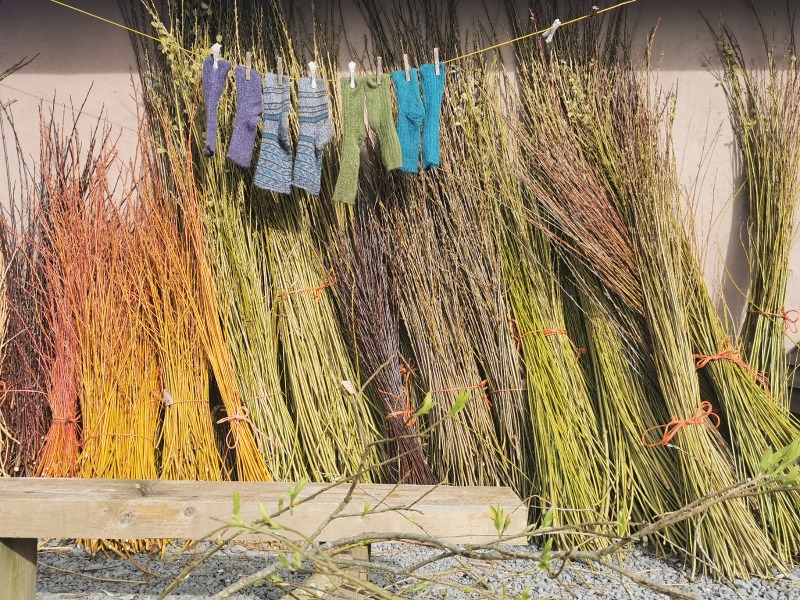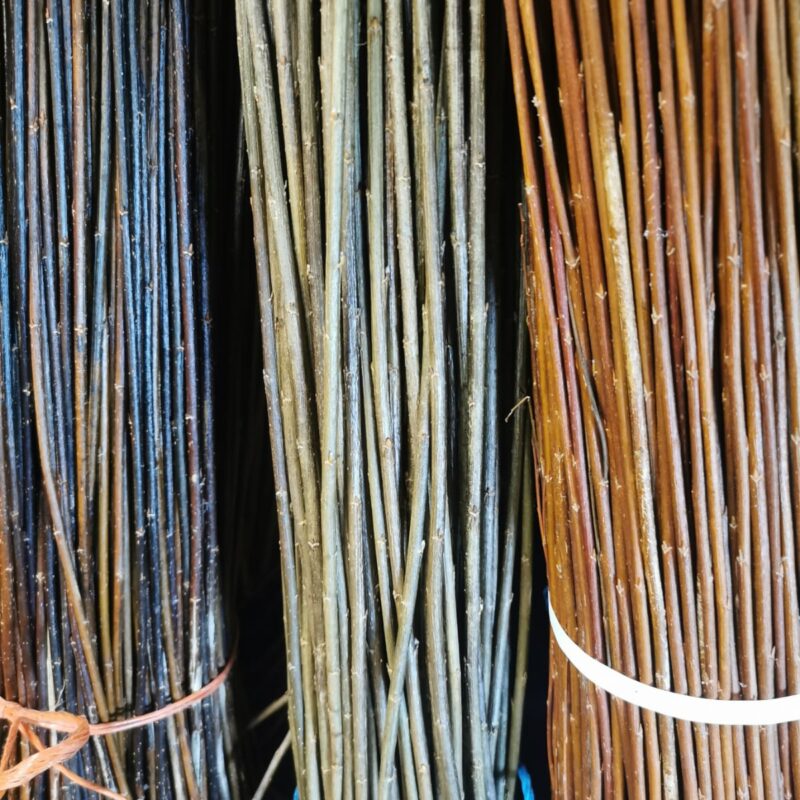Our Willow Beds
My basketry is woven using a basketry variety of willow (osier) rather than the wild native willow that grows vigorously but also very branchy, the Osier grows very tall and straight in its first year of growth, heading straight up to the sky before setting branches or side shoots, in its second year. This enables it to be harvested at the end of this first season to provide long supple rods for weaving. As the winter sets in, the leaves fall and the sap returns to the roots effectively putting the plant to sleep, protecting it from the harsh winter cold and winds. This is the time to harvest. When the rods are completely bare, I cut each rod as close to the ground as I can, a clean cut to allow it to heal and seal over. The rods are then collected and bundled and left to start the drying process, usually under a cover but still outside.
Then weekly the bundles are turned inside out to allow those inside the bundle to also dry and prevent mould or rot to start within it.
After about 6-8 weeks if the bark has become tough and a little wrinkled the willow bundles can be brought into the shed to continue drying out. The whole drying process can take upto 3 months to complete, although at around 8 weeks willow can used ‘Green’, without resoaking. As shrinkage will be minimal at this stage. Also, At this point I usually grade the bundles into height to allow the ease of choosing the appropriate material for each basket I make. A large ruler on the gable wall of my shed, allows me to sort the willow into bundles of 5’, 6’,7’ etc. As the rods get taller they are also thicker at the base. So sorting and grading helps to have evenness over the material needed for each project.
The willow is very happy to be cut every winter and this coppicing process increases its growth and vigour, much like cutting your lawn. However if you cut in the summer time whilst the sap is still flowing through the rods the stools can weep or bleed after cutting causing the loss of some of its life force. A very vigourous variety can be knocked back this way If needed. The colours of the willow I use are all natural variations and varieties, with wonderful names such as Flanders Red, Dicky Meadows, Green Dicks, Black Maul, Britney Blue, Vitalina, Daphnoids and Welsh White. Each variety responds and grows differently according to its climate, some willows will not grow well on my sea level west facing field, so I must be content to grow those that respond well to my area. Willow really prefers a wet ground and is happy enough in poor soils, it rapidly dries out wetland areas as it’s a very thirsty plant. Which suits some of my beds very well as they are close to blanket bogland. I sometimes increase my beds by laying silage plastic out and weighting with stones, this suppresses weeds whilst the willow gets going, the slips or cuttings are prepared at around 18” in length and as thick as your finger. Again planted during the winter, these are pushed about 8” through the plastic and into the soil in rows, being careful to ensue each slip is the right way up. You can tell by looking at the buds or leaf nodes, these should be facing up to the sky. The action of the bark grating against stones and soil as its pushed down, activates the growth of roots and planting early in the winter allows plenty of root growth before the sap raises and spring breaks to establish and support the new young rods and leaves to form safely. However sometimes an early frost can still cause death or damage to these soft young shoots. Usually the willow will recover, and try again, but as with all living things some cuttings will fail and need to be replaced.
A fully functioning willow bed will take 3 years to establish and cutting of the rods should continue every year to encourage more growth, the silage plastic can be removed at this stage as the threat of weeds is usually controlled enough at this point and the vigour of the willow will crowd out light for future weeds to establish. The willow absorbs carbon from the atmosphere as food and converts this to sugars for growth, in turn exhaling oxygen back into the air in return. It also provides essential habitat for nature and the pollen in its catkins are eagerly collected by hungry bees and insects as it is one of the earliest plants to flower in the spring, providing much needed food after the long harsh winter. Willow is an essential plant for our biodiversity.
The harvested material, once it is completely dry, needs to be resoaked to become supple once again for weaving. The rods are totally submerged into water and weighted to keep them under, the rule of soaking time is generally one day for each foot of growth, followed by one day out of the water and stood to allow to mellow and soften, this depends on the air and water temperature however and sometimes needs longer or shorter time submerged. A quide to testing the rods, is to kink or bend the butt end and see if the willow kinks without snapping or lifting or cracking the bark, if its soft and bends without resistance, then its usually ready to start weaving with.
I hope this explanation of the willow growth helps to put some context into the wonders of willow as a material, purely natural and strong its been used for thousands of years and I am delighted and always surprised and inspired by its vigour and growth and I’m very happy to care for my crop, perhaps I am a kind of willow shepherd. There is so much more I could say about willow, but I feel this is more than long enough for any beginner to understand.
Next time you see a willow basket, you will have some idea of the complexity behind the material and the baskets creation.. There has never been a machine produced capable of making basketry, all Baskets are hand made regardless of the type of material used, be it willow, grasses or rushes. The art and skill of Basketry truly belongs to humanity.





